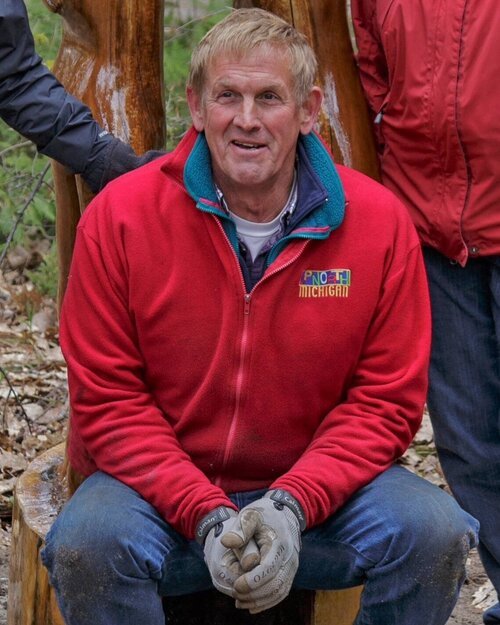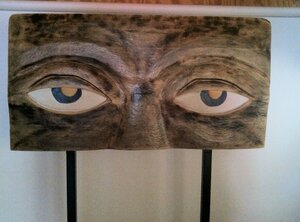Ingraham Memoriam
IN MEMORIAM: Bart Ingraham, Renaissance Man
1947-2020
by Graydon DeCamp
When Art Rapids launched the Walk of Art sculpture park in 2013 one of the first works was “The Dancers,” a stunningly realistic, life-sized waltzing couple by Suttons Bay artist Bart Ingraham. It was an instant a hit with visitors to the new outdoor gallery, and was instrumental in making the tired, old county day park into one of the region’s top “must-see” attractions.
Phased out after three years under the Walk of Art protocol, “The Dancers” was hardly Ingraham’s last sculpture in the park. It was just the beginning. He followed it the very next year with “Lotus,” a life-size wood carving of a cross-legged yogi who floated three feet off the ground at the end of a long, leafy trail.
Since then, so many Bart Ingraham sculptures have graced the Walk of Art that his death last month of pancreatic cancer leaves a massive void in the hearts of his Art Rapids friends and admirers and the thousands of park visitors who have enjoyed his work.
Born in 1947, Bart grew up helping work the family farm downstate near Rockford. In high school he was as popular as he was academically gifted, a leader in 4-H, voted homecoming king. When he went off to college at Colorado State, it was on a full football scholarship. There, in a zoology class, he met a girl named Gail. She was a perfect match – inquisitive, artistic, talented, adventuresome. They married soon after graduation and gave two years of service to the Peace Corps in the Philippines before Bart brought her back to Michigan. He and his beloved Gail settled on Shady lane near Suttons Bay and collaborated in building and operating Bellwether Gardens nursery for three decades.
All through those years Bart was active in Traverse City’s Old Town Players, and his rich bass-baritone voice helped lay firm foundations for such choral groups as Canticum Novum. His sculptures were as varied as his talents. Where “The Dancers” charmed us, his giant “Blue Eyes” startled us as it peered from the cover of the Walk of Art forest. He loved talking of them, sharing his thoughts and inspirations. These are gone from the park now, but several of his pieces remain as his bequest to Art Rapids.
“Lotus,” he once told us, “is carved from a piece of spruce windfall in my neighbor's yard. He knew I was a carver and asked if I wanted it. I didn't know at first what was inside it.”
He walked around it for a year before realizing it was a yogi in the “lotus” sitting position – a discovery he said was “a surprise to me. ‘The Lotus’ is a self-portrait. I do yoga almost every morning, and the lotus is always the position I end my work with. I would sit there and look down at myself and my feet and contemplate, 'How do you carve your feet crossed over your legs? This will be really difficult!' And it was.” Atop a light, graceful pedestal, it appeared suspended in mid-air among the trees. "I wanted it to be a part of nature, yet apart. I wanted it to have an ethereal sense -- part of the earth, but not anchored to the earth – just as we are part of the earth and still not part of it."
“The Dancers,” he once said, are “really representational of my wife and me. We fell in love on the dance floor and continued the dance for over forty years.” He longed, he said, “ to carve a couple dancing.”
One day he was offered a gigantic, black walnut log, seven feet long and three feet across, so damaged by carpenter ants it was unsuited for milling. “Now I had a log big enough to make the dancers come to life. And the ants made my work much easier by creating a void which became the space between the dancers.
“It represents, to me, my dance through life with my partner. Sometimes you lead and sometimes you follow, always moving to the unheard music of life and hoping to do it gracefully while making as few missteps as possible.”




